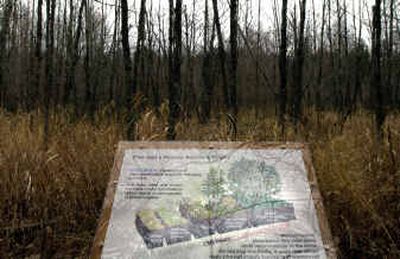WaterLife center taking shape

SNOW-CAPPED HILLS rise above a spattering of mustard-colored tamaracks. A grassy coastline hugs an amber wetland field.
The site of the 1909 Sandpoint Fish Hatchery provides a riverfront vista as well as access to the shoreline for the public, birds and waterfowl alike.
Thanks to donations of labor, materials and cash, the WaterLife Discovery Center on the Pend Oreille River is making progress. The habitat education center and interpretive area is an effort of the Idaho Department of Fish and Game and the Idaho Fish and Wildlife Foundation. Project supervisor Mark Taylor of Fish and Game considers the community an equal partner.
“Every time I turn around, some excited person shows up and asks ‘How can I help?’ ” he said.
The fish-viewing pond and stream remain empty, but hardscape was completed over the summer. Federal funds paid a team of Job Service teens to place rock and topsoil on the 3.3 acre site along Lakeshore Drive.
Across the street, 6.6 acres of wetland trails were in need of signs to teach visitors about plants and wildlife. Sandpoint Eagle Scout Terry Taylor (no relation to Mark Taylor) volunteered to take the task as part of a leadership project and led 10 adult and youth workers in constructing wooden frames that will hold interpretive signs. Three large and nine small information signs were placed on the nature trail.
The eighth-grader liked working on a project that other kids will be able to enjoy for years to come.
“I was really excited about it,” he said. “Every time we go out there, there’s something new.”
He encourages other Scouts to get involved and suggests that building benches for along the trail would make a great addition.
The stream and pond intended to house native fish still need to be linked to the river. A pavilion, restrooms and boat dock are awaiting construction as well. The 1940 bungalow that once housed the hatchery caretaker needs to find a new location to shed its peeling paint. The building is slated for public auction.
Mark Taylor said that time and money are the main deterrents to the project’s completion.
“It’s slower than I’d like it to go and this has such potential,” he said. “At least it’s going.”
Between donations and grants, $83,000 of the needed $300,000 has been raised. Taylor has been pleased with the community’s response throughout his two years of working on the WaterLife Discovery Center, which was first envisioned in the mid-1990s. A fund-raising campaign is under way, selling engraved stones that will decorate the fish-viewing wall. Checks arrive from local businesses and calls come from as far away as Portland with offers of help, Taylor said. The public has bestowed shovels, wheelbarrows, excavation and marketing skills upon the project.
“We need something and it shows up,” Taylor said. “The community ties are incredible.”
A concrete wall was designed for underwater viewing windows and stands ready for face-to-face encounters with a favorite fish. Eventually, the pond will be stocked with endangered bull trout, cutthroat and northern pike. Taylor hopes the art community will join in and create signs that will be informative as well as artistic. He envisions teachers including art in their lesson plan when they take a field trip to the site.
“The possibilities are mind boggling,” Taylor said.
The Kinnikinnick chapter of the Idaho Native Plant Society and Master Gardeners contributed expertise, time and foliage to the project. Taylor appreciated the Saturday they spent in October planting 200 native plants and spreading the “soil conditioner” that he received.
“The stable I got it from didn’t call it that,” he said.
The 20 gardeners trudged into their woods early that morning and dug up greenery to brighten the muddy landscape. Many of the members live on property that offers a good variety of native plants. Native Plant Society member Eileen Atkisson lives in town, but still unearthed a yarrow plant from her Sandpoint yard to share.
“We all had our hands in the dirt and manure that day,” she said.
An eagle flew over the volunteers, offering a nod of approval.
“We were trusting that was a good sign,” she said. “We know that all of the plants won’t make it.”
Transplanting natives can be tricky, Atkisson said. For the best results, one must dig down as far as possible and transplant the same day. Design plans included a spot for sumac, pussytoes and elderberry. Young larch and kinnikinnick were added to the mix. Showy flowering plants were chosen for their anticipated splendor come spring.
Atkisson and her group plan to help maintain the landscape and work on identification signs. She said she is proud to be a part of a project that has involved so many people and will preserve a piece of the waterfront.
“It’s great to tell family and friends that this is what I worked on and it will be available for years to come,” she said. “They’ve just carved something out of an area that really wasn’t being used and it’s a whole new world.”